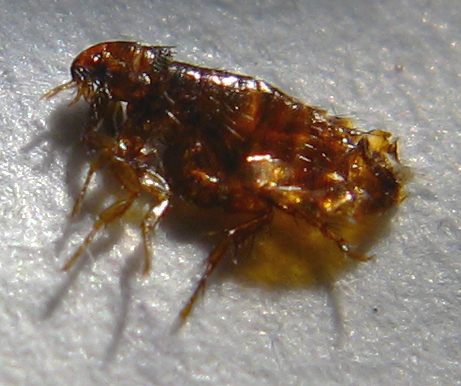SERVICE REQUEST?
Fill out the form below.
Find our nearest location
Your Local Office

Cat Flea
Attribution: Outesticide, [GFDL or CC-BY-SA-3.0-2.5-2.0-1.0]
Size:
Tiny insects measuring about 1/6-inch in length and are laterally flattened.
Color:
Reddish brown.
Behavior:
One female flea can lay about 18 eggs a day and just 20 fleas on a dog can produce 360 eggs per day and over 2000 eggs in a week. After the home is treated, it may take up to two weeks or more before fleas are no longer seen. The reason for this is that flea pupae are unaffected by the treatment until the adult fleas emerge from their pupal cocoon. In any flea population, all stages of the flea will be present including numerous pupae. It will take several weeks for all adult fleas to emerge from these pupae and contact the treatment. Vacuuming as often as possible after the treatment can speed up this process because it stimulates adult fleas to emerge from their cocoons.
Fleas are ectoparasites of animals, meaning they live on the outside of the body and need to feed on the blood of these animals in order to produce eggs. Because fleas usually feed and lay their eggs while the pet is sleeping, the pet’s resting areas are where the most fleas will be found. Many pets acquire fleas outside in the yard. Research has demonstrated that urban wildlife, such as raccoons and opossums, are commonly responsible for introducing these insect pests onto residential properties where the pets can encounter them.
Controlling a flea infestation successfully requires four steps:
- Preparation for treatment.
- Treatment of pets.
- Treatment of the inside premises.
- Treatment of flea activity sites outside.
Obviously, the pet is critical to minimizing flea infestations and regular grooming helps to limit fleas on the pet. For this reason, customers need to keep the pet groomed and treated with on-animal flea control products. Step One. Any flea treatment will be less effective if the home is not prepared properly by completing the following steps:
- Remove all items, such as toys, clothes, and pet food from all floors.
- Remove all items from under beds and in the bottom of closets.
- Wash or replace pet bedding.
- Vacuum all carpets and rugs thoroughly, including beneath beds and upholstered furniture.
- Clean all wood, tile, and linoleum floors by sweeping and mopping.
- Clean concrete floors with soap and water in the garage,basement, or enclosed patio where pets rest or stay.
- Remove all pets including birds and reptiles. Cover fish tanks with a damp towel and turn off the air pump.
- Replace any pet bedding outdoors and make all shaded areas, crawl spaces, etc. available for treatment.
- Arrange to be out of the home for several hours until the treatment has thoroughly dried.
Step Two. The homeowner needs to arrange for treating the pet. A number of on-animal treatment products are now available. Treatment of pets should be done under the direction of a veterinarian. Step Three. In homes that have an active flea infestation, a residual treatment combined with an insect growth regulator should be applied. A professional, like Terminix, can best accomplish this treatment by using specialized equipment. Efforts should be focused on the areas where pets rest or sleep. These are the sites where the most fleas will be located. Step Four. Outside, treatment should be applied to shaded areas and beneath shrubs and decks where pets rest or sleep. Again, a professional has the right equipment to provide this treatment effectively.
Family Name:
Centocephalides felis
Read What Our Clients
Are Saying
My Terminix tech Scott is the best! He is professional, courteous and absolutely thorough about his job. Thank you for sending such a blessed tech to my house. Hamlet, NC
This letter is to say how pleased we are here at Morreene West Apartments with your services. We are very pleased with the technician, Christopher. He does a great job. Durham, NC
Terminix has consistently offered our apartment complex reliable, competent service. We are completely satisfied with their knowledgeable representative who is always punctual and does a superior job for us every time. Chapel Hill, NC
I would like to take the time to thank you for giving us such great service here at Carver Pond Apartments. Your Pest Technician Christopher Mitchell has provided us with excellent service over the last few months. Christopher is such a great help to us in providing helpful information so that we can better serve our residents here at Carver Pond. Durham, NC
SERVICE REQUEST?
Fill out the form below.